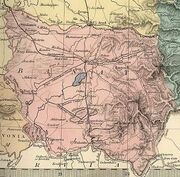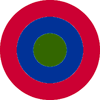| |||||||
| Capital (and largest city) |
Timişoara/Temeschwar | ||||||
| Language official |
Roumanian, German, Serbo-Croat, Hungarian | ||||||
| others | Yiddish | ||||||
| President of the Executive Council | Salko Jankovic | ||||||
| Chair of the People's Council/First Minister* | Suzana Hoth | ||||||
| Area | 9776 km² | ||||||
| Population | 1677061 | ||||||
| Established | 1922 (Second Congress of Berlin) | ||||||
| Independence | from Austria-Hungary | ||||||
| declared | 31 October 1918 | ||||||
| Currency | BanatThaler | ||||||

The borders of the Banat region in circa 1870. These borders were confirmed as the national borders in 1922 during the Second Cogress of Berlin.
The Banat Republic is a landlocked county in south central Europe bordered by Roumania, Hungary, and Jugo-Slavia and Serbia.
Formation
Following the armistice ending hostilities in World War I and the perceived imminent collapse of the Austrian-Hungarian Empire during the New York Peace Accords many wanted to maintain the integrity of the multiethnic Banat region especially after the proclamation by Karl I of the formation of a federative state. Many of the nationalities of the Empire sought complete independence and on October 31st military councils were established by the different nationalities living there: Romanian, Hungarian, German, Jewish, and Serb. On November 1st Otto Roth announced the creation of the Republic of Banat. It's constitution proclaimed the Banat People's Council, which would have representatives from each ethnic group. The council had 20 members from the city council of Timişoara, the capital of Banat, 60 from the military national councils, 40 from workers councils, and 70 from bourgeois parties. Then an executive council of 20 was elected. This governing structure has remained with little change. Today, the Executive Council elects a President from among the members of the council. *The people's council elects a chair, who serves as first minister in the cabinet. The allocation of seats to the military national councils and the workers councils remains controversial to this day. The method for allocating seats to the workers councils has remained the same since 1918 and is the only "soviet" government still in existence. See main article Banat government.
Military squads and a civil guard were organized on November 4th in order to take control of the country.
At first only Romania recognized the Banat Republic. The Romanian plurality, which disagreed with the formation of the Banat Republic at first was convinced to support it through negotiations by November 5th, and a delegation of Romanian diplomats convinced Romania to recognize the country on November 10th. The Hungarian parliament, having officially severed ties with Austria, was hesitant to recognize a country within its own borders but was forced to do so when Germany issued the statement "Der Banater Volksrat ist die einzige Regierung des ehemaligen Kronenlandes von Banat." Despite this awkward statement, Germany communicated clearly an intention to prevent any bloodshed in the region or the outbreak of war between or among the de-facto independent Hungary, the State of the South-Slavs, and Romania which all had claims to the territory. Additionally Germany sought to protect the sizable ethnic German plurality and manage the situation in the unstable Austria-Hungary. This statement effectively guaranteed borders of the republic whether as a sovereign nation or, at that time preferably, part of Austria-Hungary. The German position was not clear, and historians generally agree, within the German government, there was considerable debate as to how to manage the instability within Austria-Hungary.
The Banat Republic was not recognized at the New York Peace Accords (nor was Jugo-Slavia, Wilson choosing only to receive separate Austrian, Czech, and Hungarian delegations from "Austria-Hungary") The Banat Republic independence and neutrality was confirmed during the Second Congress of Berlin in 1922, which resulted in the formal end of Austria-Hungary . The re-route of the Berlin to Baghdad Railroad through the Banat, to avoid Serbia, and to favor areas nominally or formally allied with Germany also benefited the Banat economy and provided a necessary counterbalance to divisive tensions within the country as the local railworks and infrastructure were organized as a state held "People's" company.
Flag and Arms

Aircraft roundel
The colours of the Banat represent a combination of the traditional colours of Wallachia, Danube Swabians, the Southern Slavs, and the Hungarians representing the principle ethnic groups in the Republic. The Arms were adapted from the arms of the Tenes county with the Imperial eagle, Cross of St Stephen, and the lion representing the historical regions, and the five short towers of the castle the five principal ethnic groups of the republic. The aircraft roundel contains the national colours.
Third Balkan War
Banat was able to maintain its unity and neutrality during the Third Balkan War despite severe internal strife due to the ethnically divided Banat government. Political affiliation has always been divided primarily along ethnic lines with the largest ethnicities except for the Germans (Romanians, Serbs and Hungarians) wanting to join Romania, Serbia or Hungary respectively. Banat is still independent and stable, because no ethnicity ever manages to reach a majority.
Later
The Banat Republic is a member of the European Economic Community
See also
| This Europäische Wirtschaftsgemeinschaft 1919 article is a stub
|



